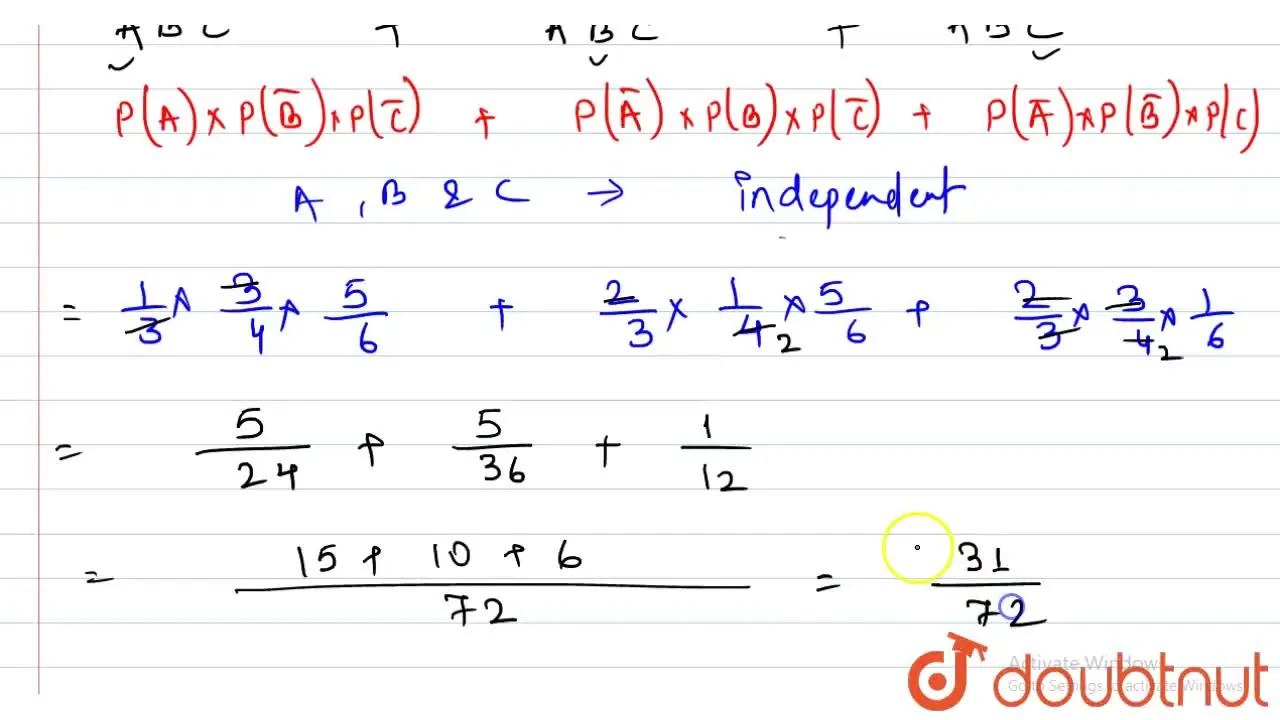The probalities of A, B, C solving a problem are ⅓, ¼ and .1/6 respectively. If all the three try to solve the problem simultaneously, find the probability that exactly one of them will solve it.
The correct Answer is:3172
Given P(A)=13,P(B)=14 and P(C)=16
⇒P(¯¯¯A)=(1−13)=23,P(¯¯¯B)=(1−14)=34 and P(¯¯¯C)=(1−16)=56.
∴ required probability
=P (exactly one of them solves the problem)
=P[(A∩¯¯¯B∩¯¯¯C)os(¯¯¯A∩B∩¯¯¯C)or(¯¯¯A∩¯¯¯B∩C)]
=P(A∩¯¯¯B∩¯¯¯C)+P(¯¯¯A∩B⋂¯¯¯C)+P(¯¯¯A∩¯¯¯B∩C)
={P(A)×P(¯¯¯B)×P(¯¯¯C)}+{P(¯¯¯A)×P(B)×P(¯¯¯C)}+{P(¯¯¯A)×P(¯¯¯B)×P(C)}.
Related Playlists
- BOOK - RS AGGARWALCHAPTER - PROBABILITYEXERCISE - Exercise 29 B2videos
PROBABILITY
- BOOK - RS AGGARWALCHAPTER - PROBABILITYEXERCISE - Exercise 29A17videos
PROBABILITY
- BOOK - RS AGGARWALCHAPTER - METHODS OF INTEGRATION EXERCISE - Objective Questions Ii56videos
METHODS OF INTEGRATION
- BOOK - RS AGGARWALCHAPTER - PROBABILITY DISTRIBUTIONEXERCISE - Exercise 3232videos
PROBABILITY DISTRIBUTION
Similar Questions
The probabilities of A, B and C solving a problem are 1/3, 2/7 and 3/8 respectively. If all the thee try to solve the problem simultaneously, find the probability that exactly one of them can solve it.
View SolutionIf rs. 2800 is 2/7th of the value of a house, the worth of the house in rs. is?
View SolutionThe probabilities of A, B and C solving a problem are 1/3, 2/7 and 3/8 respectively. If all the thee try to solve the problem simultaneously, find the probability that exactly one of them can solve it.
View SolutionThe probabilities of A, B and C solving a problem are 1/3, 2/7 and 3/8 respectively. If all the thee try to solve the problem simultaneously, find the probability that exactly one of them can solve it.
View SolutionThe probabilities of A and B solving a problem independently are13and14respectively. If both of them try to solve the problem independently, what is the probability that the problem is solved?
View SolutionThe probabilities that A and b can solve a problem independently are 13 and 16 respectively. If both try to solve the problem independently, find the probability that:
(i) problem will be solved
(ii) both can solve the problem.View SolutionThe probability of solving a specific problem independently by A and B are 13 and 15 respectively. If both try to solve the problem independently, find the probability that the problem is solved.
View SolutionProbabilities of solving a specific problem independently by A and B are 12 and13 respectively. If both try to solve the problem independently, find the probability that (i) the problem is solved (ii) exactly one of them solves the problem.
View SolutionProbability of solving specific problem independently by A and B are 12 and 13 respectively. If both try to solve the problem independently, find the probability that :
(i) the problem is solved
(ii) exactly one of them solves the problem.View SolutionProbability of solving specific problem independently by A and B are 12 and 13 respectively. If both try to solve the problem independently, find the probability that (i) the problem is solved (ii) exactly one of them solves the problem.
View Solution


